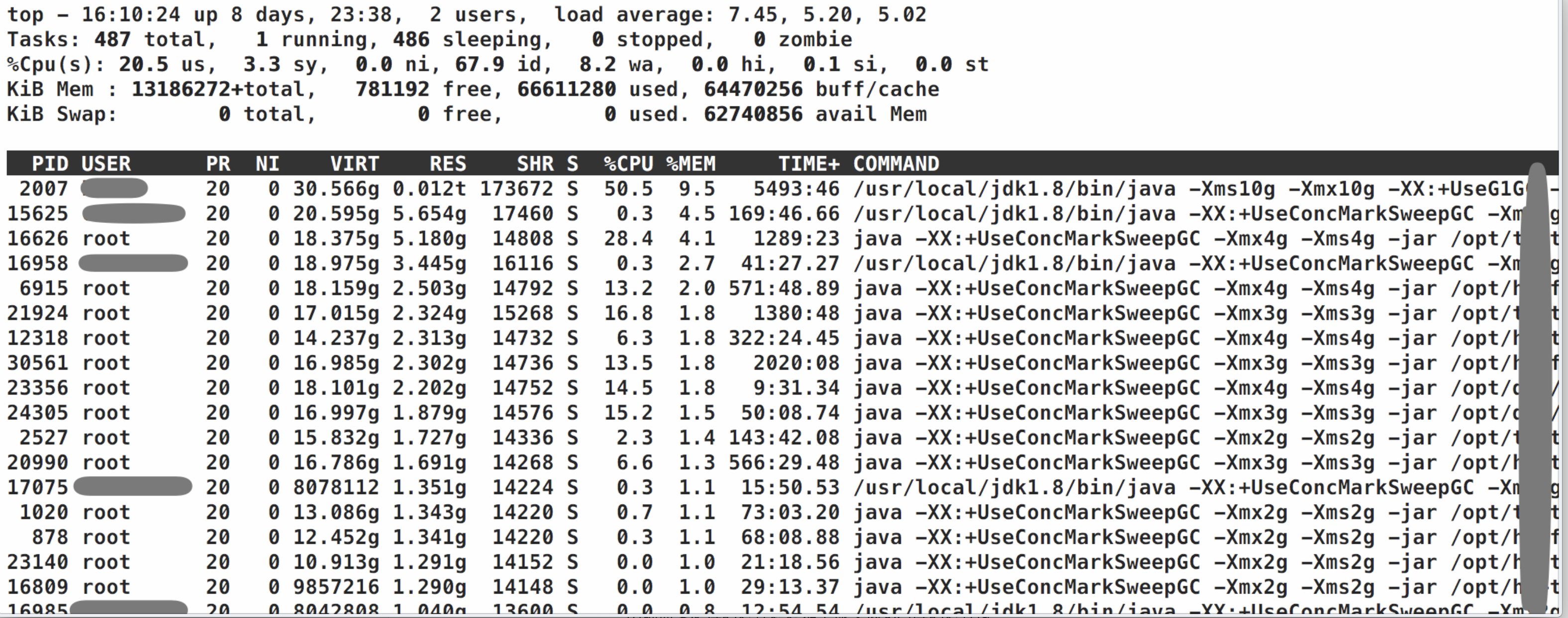您好,登錄后才能下訂單哦!
您好,登錄后才能下訂單哦!
本篇內容介紹了“Java怎么獲取線程狀態及堆棧信息”的有關知識,在實際案例的操作過程中,不少人都會遇到這樣的困境,接下來就讓小編帶領大家學習一下如何處理這些情況吧!希望大家仔細閱讀,能夠學有所成!
出現內存泄漏或者運行緩慢場景,有時候無法直接從業務日志看出問題時候,需要分析jvm內存和線程堆棧
線程堆棧信息主要記錄jvm線程在某時刻線程執行情況,分析線程狀態可以跟蹤到程序出問題的地方 內存堆棧信息主要記錄jvm堆中在某時刻對象使用情況,主要用于跟蹤是哪個對象占用了太多的空間,從而跟蹤導致內存泄漏的地方
actuator
1.x
http://host:port/metrics/threads //當前進程的線程數 http://host:port/metrics/threads.daemon //當前進程后臺駐留線程數 http://host:port/metrics/threads.peak //當前進程線程數峰值
2.x
http://host:port/actuator/metrics/jvm.threads.daemon //當前進程后臺駐留線程數 http://host:port/actuator/metrics/jvm.threads.live //當前進程的線程數 http://host:port/actuator/metrics/jvm.threads.peak //當前進程線程數峰值
hystrix 線程狀態
如果接入了turbine可以直接通過turbine查看整個集群狀態

當集群較大的時候,單純想看hystrix線程池狀態,可以單獨從hystrix監控統計類里面獲取
http://host:port/sys/hystrix/threads
源碼如下:
import com.alibaba.fastjson.JSON;
import com.netflix.hystrix.HystrixThreadPoolMetrics;
import org.slf4j.Logger;
import org.slf4j.LoggerFactory;
import org.springframework.jmx.export.annotation.ManagedResource;
import org.springframework.scheduling.annotation.EnableScheduling;
import org.springframework.scheduling.annotation.Scheduled;
import org.springframework.web.bind.annotation.GetMapping;
import org.springframework.web.bind.annotation.RequestMapping;
import org.springframework.web.bind.annotation.RestController;
import java.util.List;
import java.util.stream.Collectors;
/**
* @author yugj
* @date 19/5/5 22:17.
*/
@RestController
@RequestMapping(path = "/sys/hystrix")
@ManagedResource(description = "hystrix Endpoint")
@EnableScheduling
public class HystrixThreadPoolEndpoint {
private boolean showStats = false;
private static final Logger log = LoggerFactory.getLogger(HystrixThreadPoolEndpoint.class);
@GetMapping(value = "/threads")
public List<HystrixThreadStats> threadStats() {
return HystrixThreadPoolMetrics.getInstances().stream().map((m) -> {
final HystrixThreadStats stats = new HystrixThreadStats();
stats.poolName = m.getThreadPoolKey().name();
stats.cumulativeExecuted = m.getCumulativeCountThreadsExecuted();
stats.currentActiveCount = m.getCurrentActiveCount().intValue();
stats.currentCompletedCount = m.getCurrentCompletedTaskCount().intValue();
stats.currentCorePoolSize = m.getCurrentCorePoolSize().intValue();
stats.currentLargestPoolSize = m.getCurrentLargestPoolSize().intValue();
stats.currentMaxPoolSize = m.getCurrentMaximumPoolSize().intValue();
stats.currentPoolSize = m.getCurrentPoolSize().intValue();
stats.currentQueueSize = m.getCurrentQueueSize().intValue();
stats.currentTaskCount = m.getCurrentTaskCount().intValue();
return stats;
}).collect(Collectors.toList());
}
@GetMapping(value = "/setShowStats")
public String setShowStats(Boolean showStats) {
if (showStats != null) {
this.showStats = showStats;
}
return "this.show stats:" + this.showStats;
}
@Scheduled(fixedRate = 5000)
public void showStats() {
if (showStats) {
List<HystrixThreadPoolEndpoint.HystrixThreadStats> statsList = threadStats();
log.info("thread stats :{}", JSON.toJSONString(statsList));
}
}
class HystrixThreadStats {
private String poolName;
private Long cumulativeExecuted;
private Integer currentActiveCount;
private Integer currentCompletedCount;
private Integer currentCorePoolSize;
private Integer currentLargestPoolSize;
private Integer currentMaxPoolSize;
private Integer currentPoolSize;
private Integer currentQueueSize;
private Integer currentTaskCount;
public String getPoolName() {
return poolName;
}
public void setPoolName(String poolName) {
this.poolName = poolName;
}
public Long getCumulativeExecuted() {
return cumulativeExecuted;
}
public void setCumulativeExecuted(Long cumulativeExecuted) {
this.cumulativeExecuted = cumulativeExecuted;
}
public Integer getCurrentActiveCount() {
return currentActiveCount;
}
public void setCurrentActiveCount(Integer currentActiveCount) {
this.currentActiveCount = currentActiveCount;
}
public Integer getCurrentCompletedCount() {
return currentCompletedCount;
}
public void setCurrentCompletedCount(Integer currentCompletedCount) {
this.currentCompletedCount = currentCompletedCount;
}
public Integer getCurrentCorePoolSize() {
return currentCorePoolSize;
}
public void setCurrentCorePoolSize(Integer currentCorePoolSize) {
this.currentCorePoolSize = currentCorePoolSize;
}
public Integer getCurrentLargestPoolSize() {
return currentLargestPoolSize;
}
public void setCurrentLargestPoolSize(Integer currentLargestPoolSize) {
this.currentLargestPoolSize = currentLargestPoolSize;
}
public Integer getCurrentMaxPoolSize() {
return currentMaxPoolSize;
}
public void setCurrentMaxPoolSize(Integer currentMaxPoolSize) {
this.currentMaxPoolSize = currentMaxPoolSize;
}
public Integer getCurrentPoolSize() {
return currentPoolSize;
}
public void setCurrentPoolSize(Integer currentPoolSize) {
this.currentPoolSize = currentPoolSize;
}
public Integer getCurrentQueueSize() {
return currentQueueSize;
}
public void setCurrentQueueSize(Integer currentQueueSize) {
this.currentQueueSize = currentQueueSize;
}
public Integer getCurrentTaskCount() {
return currentTaskCount;
}
public void setCurrentTaskCount(Integer currentTaskCount) {
this.currentTaskCount = currentTaskCount;
}
}
}linux
ps huH p {pid}|wc -l當服務cup飆升或者出問題需要從主機層面定位時候,使用top -c 命令查看對應哪個進程占用了過高資源

找到資源占用高的進程
明確需要定位的進程通過如下命令找到對應的進程id
ps aux|grep {application alias}可以通過如下命令定位具體高load線程:
查詢進程具體哪個線程占用高load
top -Hp {進程pid}
thread id為十六進制格式轉十六進制值
printf %x {線程pid}
指定特定行數堆棧信息
jstack {進程id}|grep -A 200 {線程id}接下來通過jstack導出對應的線程堆棧
jstack 對應參數如下
-m to print both java and native frames (mixed mode)
-l long listing. Prints additional information about locks
服務器線程相對較多,文件大小較大,一般不會考慮在服務器看,另外這樣查也會導致忽略了一些統計信息
通過如下命令導出文件,下載到本地查
jstack -l {pid} >> {dump-file-path}docker環境涉及一些權限,需要進入docker執行,docker里面進程id根據實際情況,一般會聯系運維操作
“Java怎么獲取線程狀態及堆棧信息”的內容就介紹到這里了,感謝大家的閱讀。如果想了解更多行業相關的知識可以關注億速云網站,小編將為大家輸出更多高質量的實用文章!
免責聲明:本站發布的內容(圖片、視頻和文字)以原創、轉載和分享為主,文章觀點不代表本網站立場,如果涉及侵權請聯系站長郵箱:is@yisu.com進行舉報,并提供相關證據,一經查實,將立刻刪除涉嫌侵權內容。